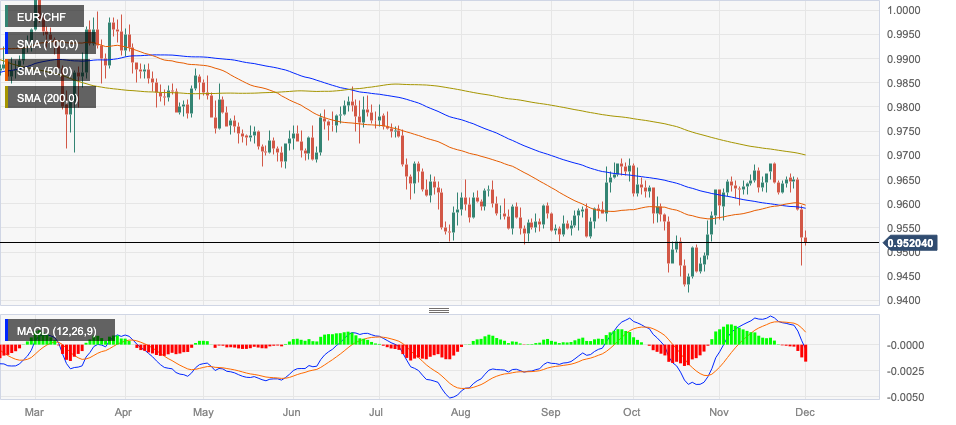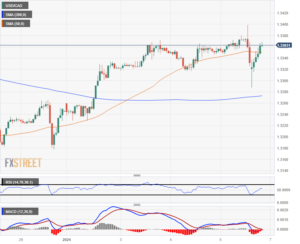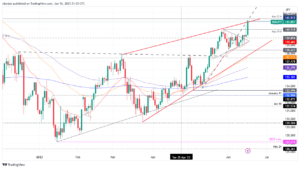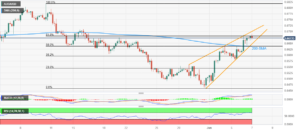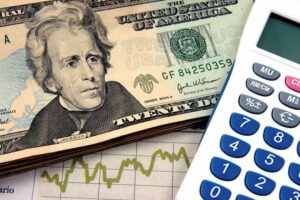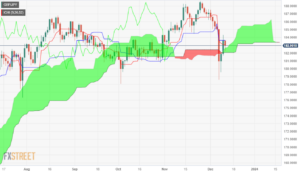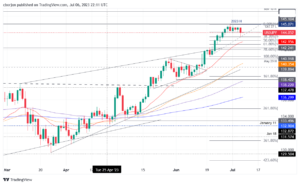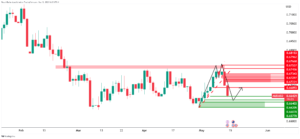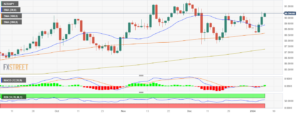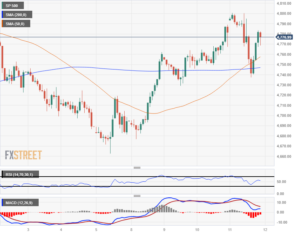- The Swiss Franc weakens after Q3 GDP data comes out mixed – YoY missing estimates; QoQ beating.
- CHF finds a floor against US Dollar as sentiment improves for the Greenback.
- EUR and GBP stabilize against Swiss Franc after a steep sell-off.
The Swiss Franc (CHF) weakened on Friday after the publication of mixed GDP data for the third quarter. On a YoY basis, the Swiss economy grew by 0.3% in Q3 versus the 0.5% expected, according to the State Secretariat of Economic Affairs. Quarter-on-quarter, however, GDP gained more than expected, helping to balance out the poor YoY result.
Most of the Swiss Franc’s major pairs found a floor on Friday after ferocious sell-offs. USD/CHF may have hammered out a low after a turnaround in bearish sentiment toward the US Dollar. The pair is down 0.65% at 0.8694 at the time of writing. EUR/CHF halted its steep decline after the Swiss GDP data. GBP/CHF likewise seems to have halted its decline.
Daily digest market movers: USD/CHF rebounds after USD finds favour
- The Swiss Franc weakens marginally after Swiss GDP growth in Q3 came out lower than analysts had forecast on a YoY basis – 0.3% vs 0.5% expected.
- The QoQ figure, however, showed an unexpected 0.3% gain versus the 0.1% expected and the 0.1% decline previously.
- The US Dollar recouped earlier losses from lower-than-expected PCE inflation data and surprise dovish commentary from Federal Reserve Board Member Christopher J. Waller.
- With global data dipping and inflation cooling in most major economies, investors now see interest rates at risk of coming down all over the world, not just in the US.
- Commentary from Federal Reserve Chair Jerome Powell on Friday is being eyed for further guidance prior to the next Fed meeting’s blackout period begins.
Swiss Franc technical analysis: USD/CHF hammers out a floor
USD/CHF – the number of Swiss Francs that one US Dollars can buy – is an overall downtrend on the short and medium-term timeframes, and in a long-term range.
Overall, the trend is biased to extend lower. The next major target to the downside is the round number level at 0.8600, followed by the 2023 low of 0.8552. A break below Thursday’s 0.8683 lows would provide bearish confirmation.
US Dollar vs Swiss Franc: Daily Chart
The pair has just found a floor at key long-term range lows and formed a textbook hammer Japanese candlestick pattern on Thursday. If Friday ends bullishly and closes above Wednesday’s open at 0.8780, it would confirm the hammer reversal and probably signal the beginning of a short-term recovery for the pair.
It is possible the pair has formed a measured move price pattern since the October 3 highs (see chart above). Measured moves are three wave patterns that look like large zig-zags. The first and third waves are usually of a similar length. If this is the case, then there is a possibility wave C may have completed. This would suggest a lull in selling pressure and the possibility of a short-term recovery. Given price has not started rising very strongly yet, however, this is still highly speculative, and the trend remains down.
Daily digest market movers: EUR/CHF ends blood-letting as ECB officials play down rate cuts
- The Swiss Franc weakened after Swiss GDP data failed to meet estimates in Q3 on a YoY basis. QoQ GDP data, however, beat estimates, helping to balance out the figures.
- The Euro weakened considerably on Thursday after flash estimates showed the Eurozone Harmonised Index of Consumer Prices (HICP) inflation decelerated more than anticipated, to 2.4% YoY in November from 2.9% in the previous month.
- Core Eurozone HICP increased by 3.6%, substantially down from October’s final print of 4.2% and missing market expectations for a 3.9% rise.
- The data suggested a risk the European Central Bank (ECB) might consider cutting interest rates, and weighed heavily on the Euro.
- Lower interest rates tend to weaken a currency as they lead to lower capital inflows.
- Despite the lower-than-expected inflation data, ECB officials have said that it may be too early to reduce interest rates.
Swiss Franc technical analysis: EUR/CHF sell-off abates
EUR/CHF – the number of Swiss Francs that one Euro can buy – fell off a cliff midweek and into Thursday. As the week comes to a close, however, it has recovered some ground and is now trading just above a major support and resistance line at 0.9520, which held up prices during the summer.
Euro vs Swiss Franc: Daily Chart
The pair is in a downtrend on all timeframes, suggesting bears have the upper hand and prices should continue lower.
A break below the 0.9470 lows would confirm the bearish bias and see prices fall to the next key support area at the 0.9417 October lows.
Daily digest market movers: GBP/CHF remains supported by hawkish outlook for BoE
- The Swiss Franc loses ground against the Pound Sterling on Friday after mixed Swiss GDP data.
- Bank of England officials are maintaining a hawkish line as inflation in the UK remains well above target, supporting the Pound.
- Interest rate-setter Megan Greene from the Bank of England expressed concerns about persistently high inflation, indicating that interest rates might need to remain elevated for an extended duration. This perspective contrasts with some recent data suggesting a potential downturn in the economy.
Swiss Franc technical analysis: GBP/CHF bouncing around on long-term range floor
GBP/CHF – the number of Swiss Francs that one Pound Sterling can buy – is broadly in a sideways trend. Thursday’s sell-off found a floor at 1.1000, a significant long-term support level and the bottom of the range.
The pair is currently trading just above support from the 50-day Simple Moving Average (SMA, Red).
Pound Sterling vs Swiss Franc: Daily Chart
Buyers and sellers are evenly balanced. A buy signal from MACD on the weekly chart coincided with the October lows. This was followed by the recovery witnessed in late October and early November. There is a chance of this move continuing. A break above the 1.1150 highs and the consolidation zone formed in early November would provide confirmation of further upside, which could see the pair claw its way back up to the long-term range highs just below 1.1500.
SNB FAQs
The Swiss National Bank (SNB) is the country’s central bank. As an independent central bank, its mandate is to ensure price stability in the medium and long term. To ensure price stability, the SNB aims to maintain appropriate monetary conditions, which are determined by the interest rate level and exchange rates. For the SNB, price stability means a rise in the Swiss Consumer Price Index (CPI) of less than 2% per year.
The Swiss National Bank (SNB) Governing Board decides the appropriate level of its policy rate according to its price stability objective. When inflation is above target or forecasted to be above target in the foreseeable future, the bank will attempt to tame excessive price growth by raising its policy rate. Higher interest rates are generally positive for the Swiss Franc (CHF) as they lead to higher yields, making the country a more attractive place for investors. On the contrary, lower interest rates tend to weaken CHF.
Yes. The Swiss National Bank (SNB) has regularly intervened in the foreign exchange market in order to avoid the Swiss Franc (CHF) appreciating too much against other currencies. A strong CHF hurts the competitiveness of the country’s powerful export sector. Between 2011 and 2015, the SNB implemented a peg to the Euro to limit the CHF advance against it. The bank intervenes in the market using its hefty foreign exchange reserves, usually by buying foreign currencies such as the US Dollar or the Euro. During episodes of high inflation, particularly due to energy, the SNB refrains from intervening markets as a strong CHF makes energy imports cheaper, cushioning the price shock for Swiss households and businesses.
The SNB meets once a quarter – in March, June, September and December – to conduct its monetary policy assessment. Each of these assessments results in a monetary policy decision and the publication of a medium-term inflation forecast.
- SEO Powered Content & PR Distribution. Get Amplified Today.
- PlatoData.Network Vertical Generative Ai. Empower Yourself. Access Here.
- PlatoAiStream. Web3 Intelligence. Knowledge Amplified. Access Here.
- PlatoESG. Carbon, CleanTech, Energy, Environment, Solar, Waste Management. Access Here.
- PlatoHealth. Biotech and Clinical Trials Intelligence. Access Here.
- Source: https://www.fxstreet.com/news/swiss-franc-pairs-chf-finishes-week-lower-after-mixed-swiss-gdp-202312011335
- :has
- :is
- :not
- $UP
- 1
- 2%
- 2011
- 2015
- 2023
- 31
- 33
- 35%
- 41
- a
- About
- above
- According
- advance
- Affairs
- After
- against
- aims
- All
- an
- analysis
- Analysts
- and
- Animate
- Anticipated
- appreciating
- appropriate
- ARE
- AREA
- around
- AS
- assessment
- assessments
- At
- attempt
- attractive
- average
- avoid
- back
- Balance
- Balanced
- Bank
- Bank of England
- basis
- BE
- bearish
- Bears
- beat
- Beginning
- being
- below
- between
- bias
- biased
- board
- board member
- Bottom
- Break
- broadly
- businesses
- buy
- Buying
- by
- came
- CAN
- capital
- case
- central
- Central Bank
- Chair
- Chance
- Chart
- cheaper
- chf
- Christopher
- Close
- Closes
- coincided
- comes
- coming
- Commentary
- competitiveness
- Completed
- Concerns
- conditions
- Conduct
- Confirm
- confirmation
- Consider
- consolidation
- consumer
- consumer price index
- content
- continue
- continuing
- contrary
- contrasts
- could
- country
- country’s
- CPI
- currencies
- Currency
- Currently
- cutting
- daily
- data
- December
- decision
- Decline
- determined
- Digest
- Dollar
- dollars
- Dovish
- down
- downside
- DOWNTURN
- due
- duration
- during
- each
- Earlier
- Early
- ECB
- Economic
- economies
- economy
- economy grew
- elevated
- ends
- energy
- England
- ensure
- Episodes
- estimates
- Euro
- European
- European Central Bank
- Eurozone
- evenly
- excessive
- exchange
- Exchange Reserves
- expanded
- expectations
- expected
- export
- expressed
- extend
- Failed
- Fall
- FAQ
- Fed
- Federal
- federal reserve
- Figure
- Figures
- final
- finds
- First
- Flash
- Floor
- followed
- For
- For Investors
- Forecast
- foreign
- foreign exchange
- foreign exchange market
- foreseeable
- formed
- found
- Franc
- Friday
- from
- further
- future
- Gain
- gained
- GBP
- GDP
- gdp growth
- generally
- given
- Global
- governing
- Greenback
- grew
- Ground
- Growth
- guidance
- had
- hammer
- hammered
- hand
- Have
- Hawkish
- heavily
- Held
- helping
- High
- High inflation
- higher
- highly
- Highs
- households
- However
- HTTPS
- hurts
- if
- implemented
- imports
- improves
- in
- increased
- independent
- index
- indicating
- inflation
- inflows
- interest
- INTEREST RATE
- Interest Rates
- intervening
- into
- Investors
- IT
- ITS
- Japanese
- jerome
- jerome powell
- june
- just
- Key
- large
- Late
- lead
- Leads
- Length
- less
- Level
- like
- LIMIT
- Line
- Long
- long-term
- Look
- look like
- Loses
- losses
- Low
- lower
- Lows
- MACD
- maintain
- maintaining
- major
- MAKES
- Making
- mandate
- March
- Market
- Markets
- May..
- means
- measured
- medium
- Meet
- Meets
- Megan
- member
- might
- missing
- mixed
- module
- Monetary
- Monetary Policy
- Month
- more
- most
- move
- Movers
- moves
- moving
- moving average
- much
- National
- National Bank
- Need
- next
- November
- now
- number
- objective
- october
- of
- off
- officials
- on
- once
- ONE
- open
- or
- order
- Other
- out
- Outlook
- over
- overall
- pair
- pairs
- particularly
- Pattern
- patterns
- pce
- Peg
- per
- period
- persistently
- perspective
- Place
- plato
- Plato Data Intelligence
- PlatoData
- Play
- policy
- poor
- positive
- possibility
- possible
- potential
- pound
- pound sterling
- Powell
- powerful
- pressure
- previous
- previously
- price
- Prices
- Prior
- probably
- provide
- Publication
- Q3
- Quarter
- raising
- range
- Rate
- Rates
- recent
- recovery
- Red
- reduce
- regularly
- remain
- remains
- Reserve
- reserves
- result
- Results
- Reversal
- Rise
- rising
- Risk
- round
- Said
- sector
- see
- seems
- sell-off
- Sellers
- Selling
- sentiment
- September
- Short
- short-term
- should
- showed
- sideways
- Signal
- significant
- similar
- Simple
- since
- SMA
- SNB
- some
- speculative
- Stability
- stabilize
- started
- starts
- State
- sterling
- Still
- strong
- strongly
- substantially
- such
- suggest
- summer
- support
- support level
- Supported
- Supporting
- surprise
- Swiss
- Swiss National Bank (SNB)
- Target
- Technical
- Technical Analysis
- term
- textbook
- than
- that
- The
- The State
- the UK
- The Weekly
- the world
- then
- There.
- These
- they
- Third
- this
- three
- thursday
- time
- to
- too
- Trading
- Trend
- Uk
- Unexpected
- Upside
- us
- US Dollar
- US Dollars
- USD
- USD/CHF
- using
- usually
- Versus
- very
- vs
- was
- Wave
- waves
- Way..
- week
- weekly
- WELL
- when
- which
- will
- with
- witnessed
- world
- would
- writing
- year
- yet
- yields
- zephyrnet


